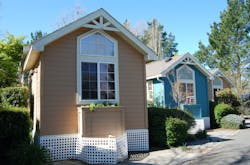Philly Advocates Pushing for Tiny Home Building Code
Appendix Q could be the key that removes the barriers to tiny house construction in Philadelphia and elsewhere in Pennsylvania.
The regulation is part of the 2018 International Builder Code that, if adopted by municipalities, would add sleeping lofts and ceilings as low as six feet in homes that are 400 square feet and smaller. Such plans are difficult to build under current codes because builders/developers have to go through the expensive and time consuming process to secure a variance.
“If we were to get Appendix Q, it would allow more flexibility and better use of the area and volume within a tiny house,” said Dave Perri, the former commissioner of the city’s Department of Licenses and Inspection. Perri, who retired in October, had argued for changes to the city code that would enable more legal options for non-traditional housing.
Dan Fitzpatrick presides over the Tiny Home Industry Association, the industry group that crafted the building code amendment. He said changing the code creates an opening for developers to build more dwellings for less money.
“They’re perfect for affordable and sustainable housing,” Fitzpatrick said of the tiny homes enabled by Appendix Q.
